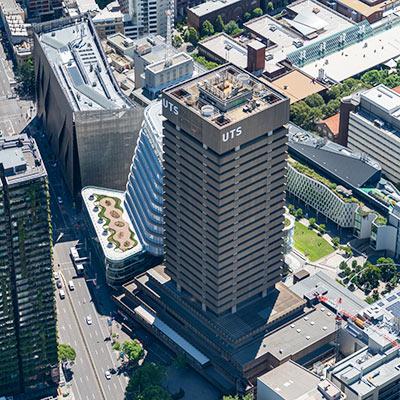For our original campus building – the UTS Tower (Building 1) – and our newest – UTS Central (Building 2) – 2019 has been a big year. UTS Central finally opened its doors in August, while the UTS Tower celebrated its 40th anniversary in October. To mark this momentous year, we asked architects with links to the respective buildings, what distinguishes these landmarks.
UTS Central (Building 2)

Richard Francis-Jones
Richard Francis-Jones, Design Director at architecture firm fjmt
Architect Richard Francis-Jones wants to get one thing straight. He may have designed the sparkling, glass-encased UTS Central, but he is also an unashamed fan of the more forbidding UTS Tower (Building 1). So much so, the Brutalist building was a source of inspiration for its contemporary neighbour.
As he explains, it’s all about context. “Whenever you’re designing a new building, you’re very influenced by what’s around you. In fact, we used this analogy of a sister to a big brother. They’re in a kind of ‘dialogue’ with each other. The weight, heaviness and rigid geometry of the Tower is complemented by the lightness, fluidity and curvilinear quality of its sister.
“In the past, the original Tower has not fared very well (in public opinion) but it’s one of the finest buildings of its era in Sydney. It’s extremely well built, very well preserved and has one of the most emblematic brutalist interiors. I feel the original Tower is easier to appreciate now because of its neighbour – it’s less dominant and more balanced. It’s like when you’re out with a great couple,” Richard laughs. “Maybe he’s a bit overbearing but interesting while she’s entertaining and more informative.”
In designing UTS Central, fjmt set out to capture the values and aspirations of UTS as a progressive, innovative, young university open to engaging with the city and community. No simple matter for a campus notoriously challenged for open space.

UTS Central is distinguished by its curves and fluidity.
“Part of our inspiration was to find an architecture that could, in some way, represent those values and take inspiration from progressive, technological ways of interpreting the natural world in architecture and space."
Richard explains that UTS Central identifies closely with the modernist tradition, an architecture informed by various principles and ideas, most particularly the embrace of technology and cutting-edge systems of construction.
“UTS Central explores a complex natural geometry, which also has a tradition in modernist architecture,” he says. “Interior spaces that reflect organic order increase our sense of comfort and wellbeing – we don’t all like living in boxes. UTS Central explores that at every level – how you move through the building, how the form of the building is determined and responds to the city and the campus, right down to the interior detailing.”
Spaces for circulation, breakout activities, student learning and informal group learning are as important as formal teaching spaces, with the building designed to facilitate movement and coincidental meetings. Lifts are hidden away in favour of escalators, while a double helix stairway is the star of the show.
“The stair is located in one of the most visible positions,” Richard says. “It invites you to travel gently around its curves, look out onto Jones St and Broadway, and across at colleagues and teachers. It’s designed to engage, draw you in, entertain and surprise you, to encourage people to move naturally.”
If there’s one space that best fulfils the architectural intentions, it is the UTS Reading Room
Richard says, “You walk into that room and see the fig trees on the terrace through the skylight, walls of books in curvilinear geometry around you, innovative leaf-like shades that automatically adjust to the position of the sun and a little spiral staircase connecting you up to the next level. Together, all of these elements embody what it is to study and learn together, surrounded by knowledge, great works and the comradery of colleagues.
“The reason universities traditionally put their library reading room in a central, honorific position on campus was because they embody the spirit of education, learning and exchange of ideas. Universities should inspire us, encourage us to be our best, and lift spirits and aspirations. Architecture like great music or a great text can lift your horizons and that’s what we’ve tried to do.”
UTS Tower (Building 1)

Rory Toomey
Rory Toomey, Principal Design Excellence, Government Architect NSW (GANSW)
“It was a golden era for the Government Architects’ Office,” says Rory Toomey of the 1960s when Michael Dysart (then employed under Government Architect Ted Farmer) designed the UTS Tower. “Many public buildings were being designed by young, innovative architects.”
It was also the era of Brutalism, which stems from the French term béton brut. Pioneered by Swiss-French architect Le Corbusier, the architectural style is typically expressed in raw, unfinished concrete, modular forms and a utilitarian appearance.
“As a building material, concrete was fast, plentiful, relatively low cost and very durable,” Rory explains. Naturally, institutions loved it.
“The best buildings in this style have a sense of gravitas and timelessness due to the purity of the materials. There is a monumental quality to them. Everything is exposed. Nothing is covered up (as it usually would be in a contemporary building) but with everything on show, the detailing had to be rigorous to stand the test of time.
“As an example, some of the brass door handles and handrails in the UTS Tower were quite sculptural and they've aged beautifully from decades of hands using them; the concrete façades have required almost no maintenance besides the occasional clean.”

The UTS Tower has a monumentality typical of Brutalist architecture.
Perhaps strangely, for a building widely considered as one of Sydney’s most instantly recognisable Brutalist landmarks, its creator rejected the term for the UTS Tower, which he saw in far simpler terms.
“Although Michael is not uncomfortable (with his buildings being described as Brutalist) he refutes the label for UTS,” confirms Rory. “Michael speaks about design from a very grounded and pragmatic, process-driven perspective, and the way I’ve heard him discuss the UTS Tower is no different.”
Detractors of the Tower may be startled to discover that the existing form is just one of seven that were intended for the campus. Due to limited funding and long delays in construction, only one and a half towers were built, the half being the old Building 2 that was demolished in 2016.
“They explored a number of masterplans for the site. Building 1 was always intended to be part of a suite of tall buildings to accommodate a very large student population. One of the criticisms of it has been that it stood alone, but now that UTS Central Park tower has been built, it’s not so isolated there as a form in the cityscape. For many years. it stood as the only tower in that part of the CBD so it was very exposed and visually prominent.
“It’s an interesting building and I appreciate its singularity,” Rory continues. "The design, using just eight main columns, made the big floor plates possible. The remarkable open space this allows on the ground plane draws people in and through the building to some huge internal spaces befitting a university but more often associated with a Great Hall or Quadrangle type of space.
“The thing that I would like to celebrate is what a young architect achieved with a constrained site, a limited budget and challenging brief. He achieved something quite rich and meaningful in the Tower’s public spaces and the way they draw people in from Broadway and through into the campus’s open spaces to the north.
“While the Tower’s not for everyone, it has an identity. As an architect, I suppose I have an appreciation for the way the materials still endure, and for the simplicity, strength and monumentality of the architecture.”

